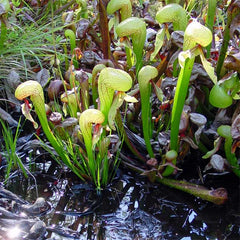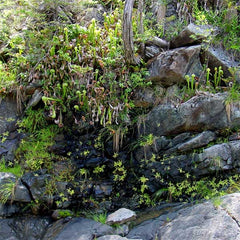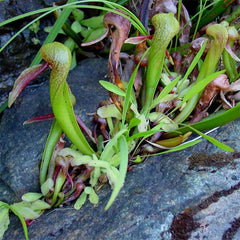
Growing Tips for Cobra Lilies



Darlingtonia californica California Pitcher Plant, Cobra Lily
Soil: 5:1 peat:sand
Container: 6+" plastic pot
Watering: moist to wet
Light: partial sun to bright shade
Zone: 6-9 (5-10).
Temperature: warm summer, cool winter-tolerates frost
Humidity: high
Location: outdoors, windowsill, terrarium, greenhouse
Dormancy: Yes.
Habitat
Darlingtonia grows in serpentine gravel soils along cold, fast running mountain streams of coastal southern Oregon and northern California, from mountain elevations to sea level (zones 6-9). They typically grow on east facing slopes. The seeps and stream sides are nutrient poor, and typically acidic from peat. Some colonies grow in slightly alkaline soils from serpentine bedrock. The key Cobra Lily habitat element is the cool, if not cold, running water, 48-68°F (9-20°C). The roots struggle in water temperatures over 60°F (15°C), though the air temperatures can be in the 80's°F (27°C). The running water keeps the roots oxygenated. There is typically a day/night change in air temperatures of 20+°. Common Carnivorous Plant companions are Pinguicula macroceras, Drosera rotundifolia and Cypripedium californicum.
Culture
Darlingtonia can be a challenge to grow, especially outside its native area. The key to Darlingtonia Californica care is mimicking its native conditions, as closely as possible. They prefer cool to warm daytime temperatures and cold or cool nighttime temperatures. They grow best when the roots are kept cooler than the rest of the plant. In full sun they tend to be shorter and redder, in partial shade they are taller and greener. Our growing beds are watered continuously with rain water stored in a large underground cistern, with a nearly constant temperature of 55°F throughout the year. The beds are outdoors in bright shade with dappled light. They grow in 8" (20cm) square, aquatic plastic pots, the kind with many holes (mesh) in the sides, often used to grow water lilies. The soil is similar to nepenthes mix with large amounts of live Sphagnum Moss. They are growing outdoors year round. During particularly hot summers here in the Mid-Atlantic the trap tops do brown and dry, but recover quickly after the heat. Some growers use the common tray method with daily doses of ice to keep the soil cool. Others use hanging orchid baskets with live sphagnum and water two or more times daily. The key culture elements appear to be cool roots, bright shade, and mineral free water.
Propagation
Darlingtonia can be propagated from root cuttings in soil or sphagnum. I have been more successful removing small plantlets from the underground stolons, and planting them up. Stolon cuttings of 2" can be placed vertically (1" deep) in wet peat, and in bright diffused light. Seeds are slow and need light, dampness, cold stratification if not fresh, and steady conditons.
Dormancy
A winter rest period (4-6 months) is required of mature plants. As day length and temperature diminish the plant will slow its growth and many of the traps may die back, starting at the tops. Traps in the winter may still trap insects and nutrient decomposition still occurs. Cut back on winter watering, but allow the soil to stay moist. Provide cooler temperatures during dormancy. A cold porch or garage may work well.
Feeding
Darlingtonia are constantly luring, trapping and digesting weary prey with their passive traps. They are quite good at this, and provided with natural access to insects they will “feed” themselves. Even indoors they will attract and capture an occasional fly or other insect. Do not feed them meat or cheese. This will likely rot and kill the trap. If feeding is desired, drop in a few dead crickets, wasps or similar insects. Freeze dried food from the pet shops works well.
Other Considerations
It is generally a good idea to remove the flower spike when it forms. If left to grow, it draws energy from the plant and can weaken a potted plant to the point of death.
They prefer steady conditions and being undisturbed. Avoid moving them about, or transplanting other than in the Spring. They send out pups more frequently when grown in tight quarters, i.e. smaller pots.
They are slow growers, slow to shed old growth, and slow to respond to changes in growing conditions.
Tall growing Cobra Lilies are difficult subjects for a terrarium, because it is hard to give such a vertically growing plant even light.
Repot every few years in a fresh Carnivorous Plant soil mix, since the peat breaks down and can create poor drainage. Plant near the edge of the pot with the growing tip pointed to the center of the pot, so that the stolons have room to grow. This is a good time to divide an already branching stolon. Repotting is best done in the Spring, before active growth begins. A soil top dressing of living Sphagnum Moss works well.
Consider growing Darlingtonia outdoors in the shade. They can tolerate freezing winters. They grow exceedingly well in a bog box or bog garden with slow running water at the root level.
Trim any browning leaves if you prefer. I cut down old traps in the Spring, well after they have had a change to absorb their nutrient rich catch from the summer before. Cutting sooner could deprive the plants of any nutrient from the traps.
If your plant appears to "die," don't give up on it for at least a year. I have found that even seemingly dead plants can regenerate from the rhizomes, much like cephalotus.
See Genus Information about Cobra Lilies.
